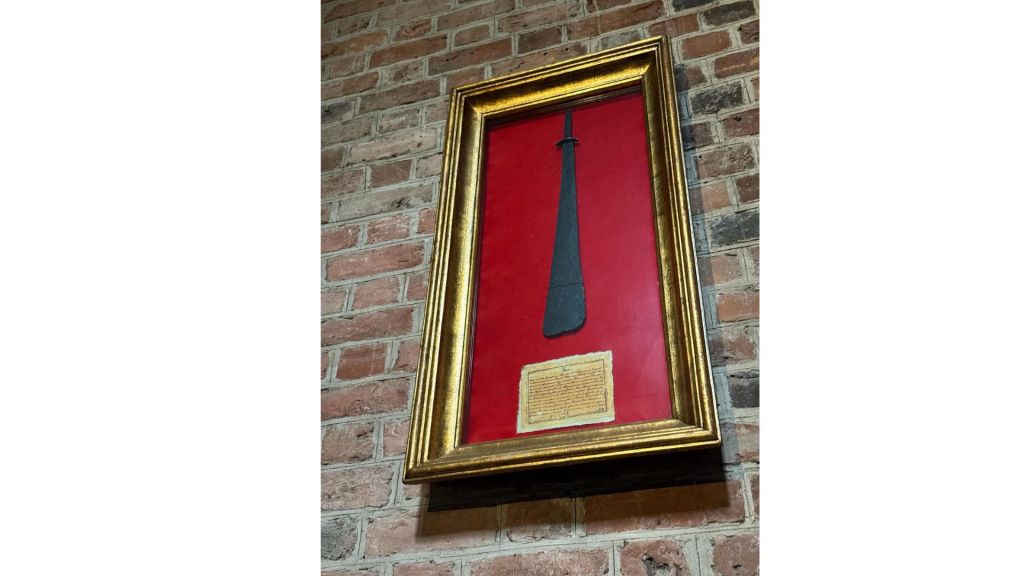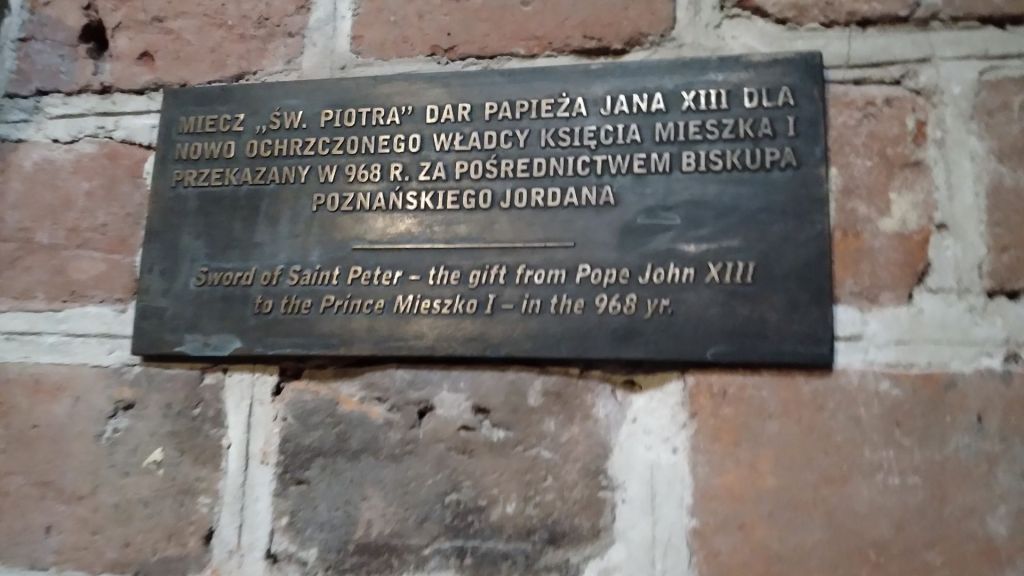Peter drew his sword
“Then Simon Peter, having a sword with him, drew it, struck the high priest's servant, and cut off his right ear. And the servant's name was Malchos" (Jn 18:10) - we read in the description of Jesus' arrest in the olive garden.
In the cathedral in Poznań, there is a glass case hanging on the wall, and inside there is a bladed weapon signed on a separate brass plaque as: "The Sword of St. Peter». A gift from Pope John XIII to the newly baptized ruler, Prince Mieszko I, given in 968 through the bishop of Poznań, Jordan. Is this the same sword that Saint mentions? John the Evangelist?


In the display case under the sword there is a copy of a page from Jan Długosz's chronicle. Here is the translation:
The Pope then announced and appointed for the Poznań Church a man of known virtue, faith and religiosity, an Italian, Jordan, from a noble Roman family, from the Orsini family and house. After consecration and blessing received in Rome, the Pope ordered him in the year of our Lord 966 to go to the Kingdom of Poland to lead the Church there. The same Pope Stephen, in order to make the beginnings of Jordan more pleasant for the Polish clergy and people, gave him the sword of St. Peter, with which the apostle, they believe, cut off the ear of Malchi in the Garden of Olives, perhaps the same sword, or perhaps another one instead, and blessed it in remembrance of such a great deed of the apostle; so that the Church in Poland has a visible jewel that it can be proud of (…). The same sword is still vehemently worshiped in the Poznań Church today.
If we visit the website of the Poznań Cathedral, we will learn that the sword hanging on the wall of the temple is a copy made in 2005. However, the original, i.e. the sword memorably used by St. Peter the Apostle , is actually in the treasure of the Archdiocesan Museum.
Treasure in the vault
The sword, or more precisely: the cleaver (as this is how this type of weapon is formally classified, used mainly for dressing fish and other animals, less often for hand-to-hand combat), is 70.5 cm long and 9.4 cm wide at its widest point. It widens downwards. It was made of iron. It probably once had a wooden handle, which has not survived to this day.
How is it possible that such a treasure is so little known in the country ? Everyone has probably heard about Szczerbiec, the coronation sword of Polish kings, kept at Wawel, and such a valuable monument - or rather a relic - is almost forgotten?
The same question was asked by participants of the session devoted to the exhibit, which took place in 2011 in Poznań.
The matter is complicated. The sword has a documented cult history spanning several centuries , e.g. in several documents from the 17th and 18th centuries we read that such a relic was kept in the cathedral in Poznań and carried in processions and presented to the people for celebration during important celebrations, e.g. on the feast of St. Peter and Paul. However, at the end of the 18th century, Bishop Ignacy Krasicki - probably on the wave of Enlightenment skepticism - banned displaying the sword to public view.
Over the years, it was shown less and less and was somewhat forgotten . How much it has been forgotten is evidenced by a photo taken in the cathedral's sacristy in 1945, which shows the effects of the robbery by the Germans - empty and scattered boxes, crates and tubes, from which the occupiers took various valuable items. Above this chaotic pile, Saint's sword hangs calmly on the wall in a display case. Peter, who apparently did not arouse the interest of the raiders.
It was only in the mid-1980s that the sword was transferred to the museum by its then director, Fr. can. Stefan Tomaszkiewicz. On his initiative, the facility was subjected to protective conservation measures.
"It would be good for [the sword] to become an icon of the city," said Aleksandra Pudelska during a conference in 2011. She noted that it is the first monument of Christian Poland and a witness of the emerging Polish state. "Poznań residents can be proud of having this treasure, and every Pole should know about it, " it is written on the museum's website.
Different opinions
It should be added, however, that not all historians are convinced of the authenticity of the exhibit. Although research carried out by scientists from the Polish Army Museum in Warsaw on the shape and type of alloy from which the cleaver was made indicates that it was forged in the 1st century AD on the eastern borders of the Roman Empire . However, representatives of the Greater Poland Military Museum are more cautious in assessing the age of the weapon and are more willing to assume that it is a medieval copy .
Even if the sword of Saint Peter does not come from the 1st century, but from the 10th or 14th century, it is an edged weapon that, next to Szczerbiec, has the longest documented history in the country . It is therefore difficult to disagree with the author of the entry on the museum's website that the exhibit deserves much greater interest than that currently surrounding it.
Sources: "The Sword of St. Peter from the Poznań cathedral. The fate of the monument" in "Ecclesia. Studia z Dziejów Wielkopolski”, vol. 6, 2011; Archdiocesan Museum in Poznań ; Wikipedia .



